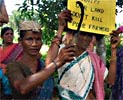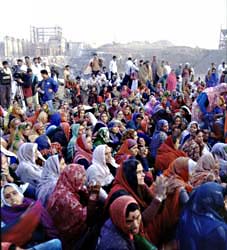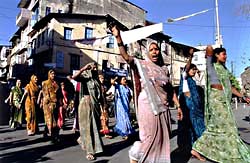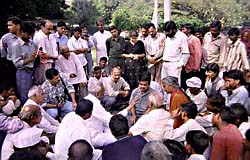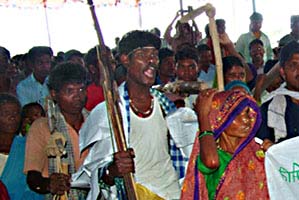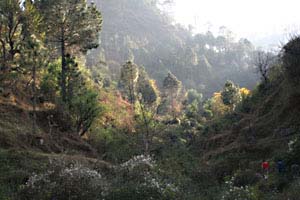The Greater Common Good - Introduction
Arundhati Roy about the Narmada Dam Project, and other big dams
Full article overview pictures
The famous Indian writer and journalist Arundathi Roy wrote a long article for Outlook magazine about the Narmada Dam Project in the West of India. She also
discuses the question how useful big projects are. Who are the winners, who the losers and who are resisting.
Some quotes from the article: "In India over the last ten years the fight against the Sardar Sarovar Dam has come to represent far more than the fight for one river. (..) It
became a debate that captured the popular imagination. (..) From being a fight over the fate of a river valley it began to raise
doubts about an entire political system. What is at issue now is the very nature of our democracy. Who owns this land? Who owns its rivers?
Its forests? Its fish?"
(..) I'm not a city-basher. I've done my time in a village. I've had first-hand experience of the isolation, the inequity and the potential savagery of it. I'm not an anti-development junkie, nor a proselytiser for the eternal upholding of custom and tradition. What I am, however, is curious. Curiosity took me to the Narmada Valley.
(Roy makes the conservative estimation that at least fifty million people, most Adivasis (indigenous peoples) are displaced in India for dams and other
big projects, since independence.) (..) Fifty million is more than the population of Gujarat. Almost three times the population of Australia. More than three times
the number of refugees that Partition created in India. Ten times the number of Palestinian refugees. The Western world today is convulsed over the future of
one million people who have fled from Kosovo.
(..)
According to the Central Water Commission, we have three thousand six hundred dams that qualify as Big Dams. (..) One thousand more are under construction.
(..) Over the last fifty years India has spent Rs.80,000 crores on the irrigation sector alone. Yet there are more drought-prone areas and more
flood-prone areas today than there were in 1947. Despite the disturbing evidence of irrigation disasters, dam-induced floods and rapid
disenchantment with the Green Revolution (declining yields, degraded land), the government has not commissioned a post-project evaluation
of a single one of its 3,600 dams to gauge whether or not it has achieved what it set out to achieve, whether or not the (always phenomenal)
costs were justified, or even what the costs actually were.
(..) According to the Land Acquisition Act of 1894 (amended in 1984), the Government is not legally bound to provide a displaced person
anything but a cash compensation. Imagine that. A cash compensation, to be paid by an Indian government official to an illiterate
tribal man (the women get nothing) in a land where even the postman demands a tip for a delivery! Most tribal people have no formal title
to their land and therefore cannot claim compensation anyway. Most tribal people, or let's say most small farmers, have as much use
for money as a Supreme Court judge has for a bag of fertilizer.
(..) Many of those who have been resettled are people who have lived all their lives deep in the forest with virtually no contact with money and the modern
world. Suddenly they find themselves left with the option of starving to death or walking several kilometres to the nearest town, sitting in the marketplace
(both men and women), offering themselves as wage labour, like goods on sale.
For the people who've been resettled, everything has to be re-learned. Every little thing, every big thing: from shitting and pissing (where d'you do it
when there's no jungle to hide you?) to buying a bus ticket, to learning a new language, to understanding money. And worst of all, learning to be
supplicants. Learning to take orders. Learning to have Masters. Learning to answer only when you're addressed.
Narmada Dam
(..) Its proponents boast that the Narmada Valley Project is the most ambitious river valley project ever conceived in human history. They plan to build 3,200 dams that will reconstitute the Narmada and her 41 tributaries into a series of step reservoirs - an immense staircase of amenable water. Of these, 30 will be major dams, 135 medium and the rest small. Two of the major dams will be multi-purpose mega dams. The Sardar Sarovar in Gujarat and the Narmada Sagar in Madhya Pradesh will, between them, hold more water than any other reservoir on the Indian sub-continent.
(..) * Urmilaben Patel, wife of Gujarat Chief Minister Chimanbhai Patel, speaking at a public rally in Delhi in 1993: "People say that the Sardar Sarovar Dam is an expensive project. But it is bringing drinking water to millions. This is our lifeline. Can you put a price on this? Does the air we breathe have a price? We will live. We will drink. We will bring glory to the state of Gujarat."
* Morarji Desai, Minister of Finance, speaking at a public meeting in the submergence zone of the Pong Dam in 1961:"We will request you to move from your houses after the dam comes up. If you move it will be good. Otherwise we shall release the waters and drown you all.
* Ram Bai, whose village was submerged when the Bargi Dam was built on the Narmada. She now lives in a slum in Jabalpur."Why didn't they just poison us? Then we wouldn't have to live in this shit-hole and the Government could have survived alone with its precious dam all to itself."
(..) Officially the number of people who will be provided drinking water by the Sardar Sarovar Canal fluctuates from 28 million (1983) to 32.5 million
(1989) - nice touch, the decimal point! - to 40 million (1992) and down to 25 million (1993).
The number of villages that would receive drinking water was zero in 1979, 4,719 in the early eighties, 7,234 in 1990 and 8,215 in 1991. When challenged, the
Government admitted that these figures for 1991 included 236 uninhabited villages!
(..)
The Bargi Dam near Jabalpur was the first dam on the Narmada to be completed (1990). It cost ten times more than was budgeted and submerged three times
more land than the engineers said it would. About 70,000 people from 101 villages were supposed to be displaced, but when they filled the reservoir (without
warning anybody), 162 villages were submerged. Some of the resettlement sites built by the Government were submerged as well. People were flushed out like
rats from the land they had lived on for centuries. They salvaged what they could, and watched their houses being washed away. 114,000 people were
displaced. There was no rehabilitation policy. Some were given meagre cash compensations. Many got absolutely nothing. A few were moved to government
rehabilitation sites. The site at Gorakhpur is, according to Government publicity, an 'ideal village'. Between 1990 and 1992, five people died of
starvation there. The rest either returned to live illegally in the forests near the reservoir, or moved to slums in Jabalpur. The Bargi Dam irrigates only
as much land as it submerged in the first place - and only 5 per cent of the area that its planners claimed it would irrigate. Even that is water-logged.
(..) Various peoples' organisations massed into a single organisation and the Narmada Bachao Andolan - the extraordinary NBA - was born. In September
1989, some 50,000 people gathered in the Valley at Harsud from all over India to pledge to fight Destructive Development.
Monumental Fight for Land and Dignity
Afterword by Peasant Autonomy
Last years the government increased the water level in the Narmada reservoir step by step. More and more villages were submerged. It is sad to say, but
the struggle against the dam is lost. In spite of huge demonstrations, impressive actions, countless court cases, excellent critical reports and a lot of
Indian and international media attention.
Still: the struggle against the Narmada Dam Project is not less than a monumental fight for the dignity and the rights of small farmers. Adivasis (tribal
people) fought together with city activists for years and years. This inspired many people from India and abroad. Nobody can say the poor farmers just
surrendered, or the activists didn't care. This struggle revealed the Truth that big dams are build at the expence of the poor people. And that no lie is
too mean for the government to enforce such a project.
The Narmada Bachao Andolan (coalition of local peoples' organisations and city activists) is still active. It is focusing now on rehabilitation and the
related corruption.
Go to next page: Arundhati Roy with the Maoist guerillas
Go to overview issues or to overview reports
